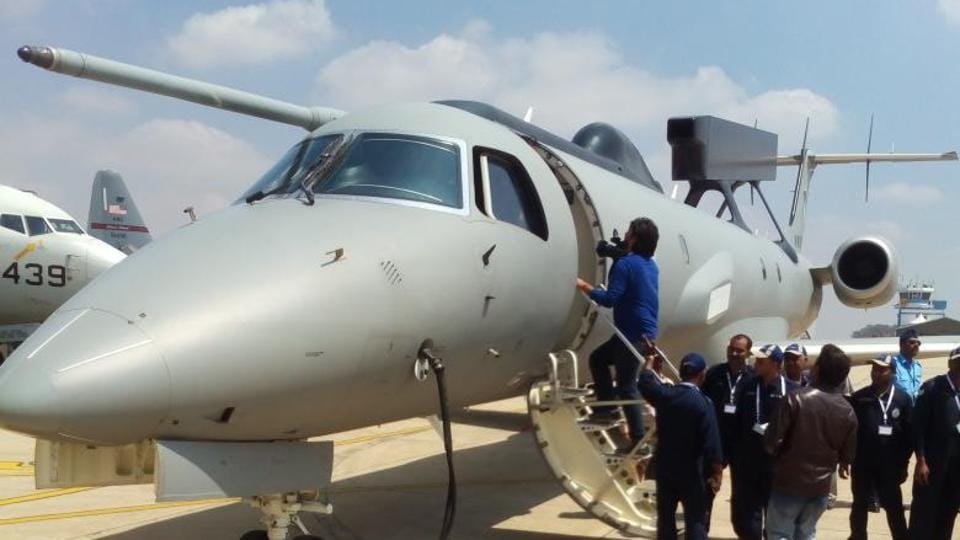Hindustani78
BANNED

- Joined
- Apr 8, 2014
- Messages
- 40,471
- Reaction score
- -47
- Country
- Location
DRDO's AEW&C: Salient features
22 Jan, 2014
Text: Agencies
With an aim of exploring the potential of exporting advanced systems to friendly countries in the region, DRDO recently showcased the Airborne Early Warning and Control (AEW&C) system at the Baharin International Airshow.
We take a look at the salient features of the indigenously developed system that DRDO is hoping to export:

Designed to detect threats
22 Jan, 2014
AEW&C system is designed to detect, identify and classify threats present in the surveillance area and act as a command and control center to support different air operations.

Meant to alert and direct fighters
22 Jan, 2014
The system with its multiple communication and data links is meant to alert and direct fighters against such threats while providing 'Recognizable Air Surface Picture' to the Commanders at the Ground Exploitation Stations.

Electronic and communication support measures
22 Jan, 2014
The system comprises of electronic and communication support measures that can interrupt and classify unfriendly radar transmissions and communication signals.
Image by DRDO

Multi sensor airborne surveillance
22 Jan, 2014
'The AEW&C system is a multi sensor airborne surveillance system. It comprises of Primary Radar (PR) and Secondary Surveillance Radar (SSR / IFF) as the active sensors onboard,' says DRDO.
Image by DRDO

Electronic Support Measure
22 Jan, 2014
The Electronic Support Measure (ESM) and the Communication Support Measure (CSM) systems aids in identification/classification, based on the various emissions from the targets.
'The Self Protection Suite (SPS) comprises of Radar Warning Receiver (RWR), which are incorporated in the ESM system, Missile Approach Warning System (MAWS) and Counter Measures Dispensing system (CMDS),' claims DRDO.
Image by DRDO

Can be adapted to other countries' needs
22 Jan, 2014
AEW&C India with Mission Systems developed by DRDO and integrated on an Embraer 145 aircraft is meant to provide a cost effective solution. According to DRDO, the system is based on modern state of art technologies and can be adapted to the needs of any country.
Image by DRDO

In-flight refuelling system
22 Jan, 2014
The platform aircraft (Embraer) is also installed with an in-flight refuelling system to facilitate extended surveillance operations. 'The AEW&C I is capable of climbing to flight altitudes from where the radar can cover from ground level to maximum required altitude to detect airborne targets at a long range,' says DRDO.

22 Jan, 2014
Text: Agencies
With an aim of exploring the potential of exporting advanced systems to friendly countries in the region, DRDO recently showcased the Airborne Early Warning and Control (AEW&C) system at the Baharin International Airshow.
We take a look at the salient features of the indigenously developed system that DRDO is hoping to export:

Designed to detect threats
22 Jan, 2014
AEW&C system is designed to detect, identify and classify threats present in the surveillance area and act as a command and control center to support different air operations.

Meant to alert and direct fighters
22 Jan, 2014
The system with its multiple communication and data links is meant to alert and direct fighters against such threats while providing 'Recognizable Air Surface Picture' to the Commanders at the Ground Exploitation Stations.

Electronic and communication support measures
22 Jan, 2014
The system comprises of electronic and communication support measures that can interrupt and classify unfriendly radar transmissions and communication signals.
Image by DRDO

Multi sensor airborne surveillance
22 Jan, 2014
'The AEW&C system is a multi sensor airborne surveillance system. It comprises of Primary Radar (PR) and Secondary Surveillance Radar (SSR / IFF) as the active sensors onboard,' says DRDO.
Image by DRDO

Electronic Support Measure
22 Jan, 2014
The Electronic Support Measure (ESM) and the Communication Support Measure (CSM) systems aids in identification/classification, based on the various emissions from the targets.
'The Self Protection Suite (SPS) comprises of Radar Warning Receiver (RWR), which are incorporated in the ESM system, Missile Approach Warning System (MAWS) and Counter Measures Dispensing system (CMDS),' claims DRDO.
Image by DRDO

Can be adapted to other countries' needs
22 Jan, 2014
AEW&C India with Mission Systems developed by DRDO and integrated on an Embraer 145 aircraft is meant to provide a cost effective solution. According to DRDO, the system is based on modern state of art technologies and can be adapted to the needs of any country.
Image by DRDO

In-flight refuelling system
22 Jan, 2014
The platform aircraft (Embraer) is also installed with an in-flight refuelling system to facilitate extended surveillance operations. 'The AEW&C I is capable of climbing to flight altitudes from where the radar can cover from ground level to maximum required altitude to detect airborne targets at a long range,' says DRDO.
















